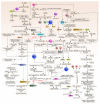Theoretical Studies on the Engagement of Interleukin 18 in the Immuno-Inflammatory Processes Underlying Atherosclerosis
- PMID: 30400655
- PMCID: PMC6274968
- DOI: 10.3390/ijms19113476
Theoretical Studies on the Engagement of Interleukin 18 in the Immuno-Inflammatory Processes Underlying Atherosclerosis
Abstract
Interleukin 18 (IL-18) is one of the pro-inflammatory cytokines expressed by macrophages, suggesting that it plays important physiological and immunological functions, among the others: stimulation of natural killers (NKs) and T cells to interferon gamma (IFN- γ ) synthesis. IL-18 was originally identified as interferon gamma inducing factor and now it is recognized as multifunctional cytokine, which has a role in regulation of innate and adaptive immune responses. Therefore, in order to investigate IL-18 contribution to the immuno-inflammatory processes underlying atherosclerosis, a systems approach has been used in our studies. For this purpose, a model of the studied phenomenon, including selected pathways, based on the Petri-net theory, has been created and then analyzed. Two pathways of IL-18 synthesis have been distinguished: caspase 1-dependent pathway and caspase 1-independent pathway. The analysis based on t-invariants allowed for determining interesting dependencies between IL-18 and different types of macrophages: M1 are involved in positive regulation of IL-18, while M2 are involved in negative regulation of IL-18. Moreover, the obtained results showed that IL-18 is produced more often via caspase 1-independent pathway than caspase 1-dependent pathway. Furthermore, we found that this last pathway may be associated with caspase 8 action.
Keywords: Petri nets; atherosclerosis; interleukin 18; macrophages; modeling; t-invariants.
Conflict of interest statement
The authors declare no conflicts of interest.
Figures







Similar articles
-
A Stochastic Petri Net-Based Model of the Involvement of Interleukin 18 in Atherosclerosis.Int J Mol Sci. 2020 Nov 13;21(22):8574. doi: 10.3390/ijms21228574. Int J Mol Sci. 2020. PMID: 33202974 Free PMC article.
-
Nicotine promotes atherosclerosis via ROS-NLRP3-mediated endothelial cell pyroptosis.Cell Death Dis. 2018 Feb 7;9(2):171. doi: 10.1038/s41419-017-0257-3. Cell Death Dis. 2018. PMID: 29416034 Free PMC article.
-
ASC controls IFN-γ levels in an IL-18-dependent manner in caspase-1-deficient mice infected with Francisella novicida.J Immunol. 2013 Oct 1;191(7):3847-57. doi: 10.4049/jimmunol.1203326. Epub 2013 Aug 23. J Immunol. 2013. PMID: 23975862
-
STAT1 as a novel therapeutical target in pro-atherogenic signal integration of IFNγ, TLR4 and IL-6 in vascular disease.Cytokine Growth Factor Rev. 2011 Aug;22(4):211-9. doi: 10.1016/j.cytogfr.2011.06.003. Epub 2011 Jul 12. Cytokine Growth Factor Rev. 2011. PMID: 21752694 Review.
-
The Two Faces of Interleukin-17A in Atherosclerosis.Curr Drug Targets. 2017;18(7):863-873. doi: 10.2174/1389450117666161229142155. Curr Drug Targets. 2017. PMID: 28034277 Review.
Cited by
-
Chronic Kidney Disease as Oxidative Stress- and Inflammatory-Mediated Cardiovascular Disease.Antioxidants (Basel). 2020 Aug 14;9(8):752. doi: 10.3390/antiox9080752. Antioxidants (Basel). 2020. PMID: 32823917 Free PMC article. Review.
-
A Control-Theoretic Model of Atherosclerosis.Int J Mol Sci. 2019 Feb 12;20(3):785. doi: 10.3390/ijms20030785. Int J Mol Sci. 2019. PMID: 30759798 Free PMC article.
-
The Mutual Contribution of 3-NT, IL-18, Albumin, and Phosphate Foreshadows Death of Hemodialyzed Patients in a 2-Year Follow-Up.Antioxidants (Basel). 2022 Feb 11;11(2):355. doi: 10.3390/antiox11020355. Antioxidants (Basel). 2022. PMID: 35204237 Free PMC article.
-
Tacrolimus reduces atherosclerotic plaque formation in ApoE-/- mice by inhibiting NLRP3 inflammatory corpuscles.Exp Ther Med. 2020 Feb;19(2):1393-1399. doi: 10.3892/etm.2019.8340. Epub 2019 Dec 17. Exp Ther Med. 2020. PMID: 32010314 Free PMC article.
-
Lipoprotein(a) induces caspase-1 activation and IL-1 signaling in human macrophages.Front Cardiovasc Med. 2023 May 24;10:1130162. doi: 10.3389/fcvm.2023.1130162. eCollection 2023. Front Cardiovasc Med. 2023. PMID: 37293282 Free PMC article.
References
-
- Boraschi D., Dinarello C.A. IL-18 in autoimmunity: Review. Eur. Cytokine Netw. 2006;17:224–252. - PubMed
MeSH terms
Substances
Grants and funding
LinkOut - more resources
Full Text Sources
Medical
Miscellaneous

